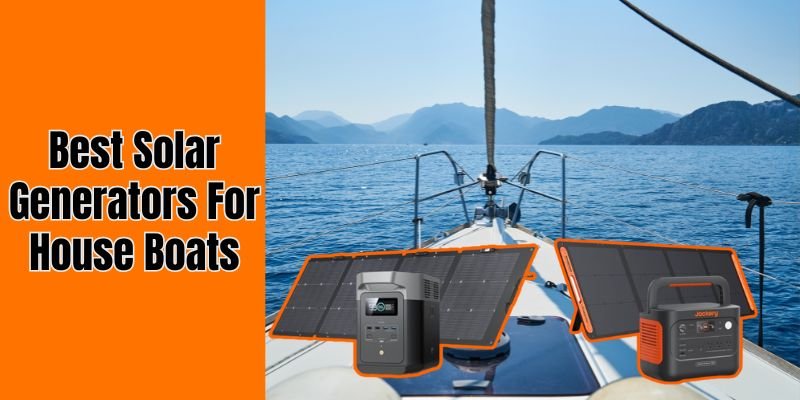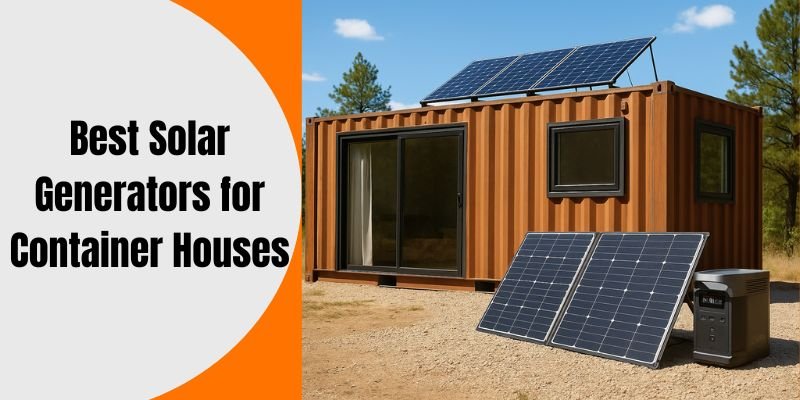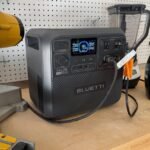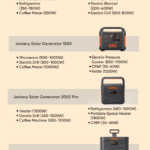Disclosure: This post contains affiliate links and I will be compensated if you make a purchase after clicking through my links. Learn More
A solar generator can power a house by converting sunlight into electricity. The right one can provide enough energy for your home’s needs.
Solar generators are becoming popular as a clean energy solution. They offer a sustainable way to keep your home running during outages or reduce dependence on the grid. Not all solar generators are created equal. Some can only power small appliances, while others can handle larger loads.
Choosing the right solar generator depends on your energy needs and budget. In this blog post, we’ll explore different solar generators and their capabilities. You’ll learn what to look for to ensure your home has reliable, green energy. Let’s dive in!

Credit: www.bluettipower.ph
Introduction To Solar Generators
Imagine having a reliable power source that doesn’t depend on the grid. Solar generators are making this possible for many homeowners. They provide a sustainable way to keep your lights on during outages and reduce your energy bills. But what exactly is a solar generator, and how can it power your house?
Benefits Of Solar Generators
Solar generators offer several advantages. They are environmentally friendly, using renewable energy from the sun. This reduces your carbon footprint. Plus, solar energy is free once you have the equipment, leading to significant savings.
Another benefit is their quiet operation. Unlike traditional generators, solar generators don’t have noisy engines. This makes them perfect for use in residential areas.
Additionally, solar generators can provide power during emergencies. They are a reliable backup, ensuring you’re never left in the dark.
How Solar Generators Work
Solar generators are surprisingly simple. They consist of solar panels, a battery, an inverter, and a charge controller. The solar panels collect sunlight and convert it into electricity.
This electricity is then stored in the battery. The charge controller manages the battery’s charging, preventing overcharging and extending its life. Finally, the inverter converts the stored DC electricity into AC power, which can be used by your household appliances.
Think of it as a mini power plant in your backyard. It harnesses the sun’s energy and makes it usable for your everyday needs.
Are you considering a solar generator for your home? It’s a practical and eco-friendly choice that offers real benefits. Why not take the step towards a greener, more reliable power solution?
Key Features To Consider
Choosing the right solar generator can seem complicated. But knowing the key features can help you make an informed decision. This guide will walk you through the most important aspects to consider.
Power Output
Power output is crucial. It determines how many devices you can run. Check the wattage rating. Higher wattage means more power. For a house, you might need at least 2000 watts.
Battery Capacity
Battery capacity affects how long your generator can provide power. Measured in watt-hours (Wh), a higher number means longer runtime. Aim for at least 3000 Wh for household use.
Portability
Consider the generator’s weight and size. Portability matters if you need to move it often. Lighter models are easier to handle. But make sure they still meet your power needs.
Durability
Durability ensures your generator lasts a long time. Look for robust materials. Weather resistance can be a bonus. Durable generators handle wear and tear better.
Top Solar Generators For Homes
Choosing the right solar generator for your home can be daunting. Solar generators provide a sustainable and efficient power source. They reduce reliance on the grid. Below, we’ll explore some top choices for home use. These generators offer reliability and sufficient power for household needs.
Goal Zero Yeti 3000x
The Goal Zero Yeti 3000X stands out for its robust capacity. It can power multiple devices simultaneously. With 3,032Wh capacity, it meets most household needs. The generator has various output ports. These include USB, 12V, and AC outlets. It also features a user-friendly display. This helps in monitoring power usage and battery status. The Yeti 3000X is an excellent choice for home backup power. It supports solar panel inputs for easy recharging.
Jackery Explorer 2000 Pro
The Jackery Explorer 2000 Pro is another top contender. It offers a 2,160Wh capacity. This makes it ideal for home use. The generator is compact and portable. It has multiple output options. These include AC, USB, and 12V DC ports. The Explorer 2000 Pro is known for its fast charging capabilities. It can be recharged via solar panels or AC outlets. This generator is perfect for those seeking reliable home power solutions.
Credit: us.ecoflow.com
Goal Zero Yeti 3000x Review
Looking for a reliable solar generator to power your house? The Goal Zero Yeti 3000X might be the perfect solution for you. In this review, we’ll break down its features, performance, and best use cases to help you decide if it’s the right fit for your energy needs.
Pros
The Goal Zero Yeti 3000X is packed with some impressive features. Firstly, it has a massive 3,032Wh capacity, which means it can power essential appliances for hours. You can run a refrigerator for over 50 hours or keep a CPAP machine running for up to 90 hours.
Another great advantage is its versatility. The Yeti 3000X comes with multiple charging options including solar, wall outlet, and car charger. This flexibility ensures you can keep it powered in various scenarios.
Durability is another strong point. The Yeti 3000X is built to last with a rugged design. It can withstand outdoor conditions, making it perfect for camping or emergency situations.
Cons
However, the Goal Zero Yeti 3000X is not without its drawbacks. One major downside is its price. It’s a significant investment, costing over $3,000. This might be a stretch for some budgets.
Another issue is its weight. Weighing in at 69.8 pounds, it’s not exactly portable. Moving it around can be challenging, especially without assistance.
Finally, the recharge time can be lengthy. Using solar panels, it can take up to 14 hours to fully recharge, depending on sunlight conditions. This can be a limitation if you need constant power.
Best Use Cases
The Goal Zero Yeti 3000X shines in several scenarios. It’s ideal for home backup during power outages. You can keep your essential devices running smoothly, ensuring comfort and safety.
It’s also great for off-grid living. If you have a cabin or RV, the Yeti 3000X provides a reliable source of energy. No more worrying about running out of power in the wilderness.
Finally, it’s perfect for outdoor enthusiasts. Whether you’re camping, tailgating, or hosting an outdoor event, the Yeti 3000X delivers clean, quiet energy.
Are you ready to invest in a solar generator that can power your house? Consider your specific needs and see if the Goal Zero Yeti 3000X fits the bill. Its pros and versatility could make it a game-changer for your energy setup.
Jackery Explorer 2000 Pro Review
The Jackery Explorer 2000 Pro is a powerful solar generator capable of powering a house during outages. Its robust battery and efficient solar panels ensure reliable energy, making it a top choice for home backup power.
The Jackery Explorer 2000 Pro is a popular solar generator. It is known for its power and portability. Many homeowners consider it to power their homes during outages. This review will dive into its features, performance, and best use cases.
Pros
The Jackery Explorer 2000 Pro has many advantages. It has a large battery capacity of 2,160Wh. This means it can run many home appliances. It can power a refrigerator, TV, and lights simultaneously. It also offers multiple output options. You get USB-C, USB-A, and AC outlets. This variety ensures you can charge various devices at once.
It is designed with user-friendliness in mind. The LCD screen is easy to read. It shows battery life and input/output status. The generator is also portable. It has a sturdy handle for easy carrying. It weighs around 43 pounds, which is manageable.
Cons
The Jackery Explorer 2000 Pro does have some drawbacks. The high price can be a barrier. It may not fit all budgets. Another downside is the recharge time. It can take up to 14 hours to fully charge using solar panels. This can be inconvenient during extended outages.
Its weight, while manageable, is still significant. Some users may find it heavy to move around. The generator also lacks an app for remote monitoring. This means you need to check the LCD screen manually.
Best Use Cases
The Jackery Explorer 2000 Pro is best for home backup power. It can keep essential appliances running during a power cut. It is also great for outdoor activities. You can use it on camping trips or outdoor events. It can power portable fridges, lights, and fans.
It is also suitable for RV owners. It can provide reliable power for devices on the road. Small businesses can benefit from it too. It can keep critical equipment running during outages. This ensures minimal disruption to operations.
“`
Comparing Top Solar Generators
Finding the right solar generator to power a house involves comparing top models. Consider factors like battery capacity, output, and efficiency.
When considering the best solar generator to power your house, it’s essential to compare the top options available. This comparison helps you understand the key differences in performance, cost, and user feedback. Let’s dive into these aspects to make an informed decision.
Performance
Performance is critical. A solar generator’s ability to provide consistent power can make or break your experience. Look for generators with high wattage and efficient solar panels.
For example, the Goal Zero Yeti 3000X offers 3,032 watt-hours, ensuring you have power even during long outages. Additionally, the EcoFlow Delta Pro boasts a rapid recharge time, which is perfect if you need a quick power boost.
Consider how the generator handles multiple devices. Some units struggle when you plug in more than a few appliances. Read reviews and check if the generator maintains steady power.
Cost
Price is always a factor. Solar generators can be a significant investment, but think long-term. A higher upfront cost might save you money down the road.
For instance, the Jackery Explorer 1000 is a mid-range option at around $1,000. It offers a balance of power and affordability. On the other hand, the Bluetti AC200P costs about $1,800 but includes advanced features like a touchscreen and a larger battery capacity.
Weigh the initial cost against potential energy savings. More expensive models may offer better warranties and longer life spans, giving you peace of mind.
User Feedback
User feedback provides real-world insights. It’s one thing to read specs, but another to hear from people who have used these generators.
Many users praise the Goal Zero Yeti 3000X for its reliability during power outages. However, some mention its heavy weight as a downside. On the other hand, the Jackery Explorer 1000 receives high marks for its portability and ease of use, but some users wish it had a faster recharge time.
Look for common themes in reviews. If multiple users mention a specific issue, it’s likely something you’ll encounter too.
In summary, choosing the right solar generator involves balancing performance, cost, and user feedback. By considering these factors, you can find a generator that meets your needs and keeps your home powered efficiently.
Installation And Maintenance
Solar generators like the Goal Zero Yeti 3000X can power a house. They are efficient and provide reliable backup energy. Maintenance involves regular check-ups and battery care.
Setting up and maintaining a solar generator for your house can seem daunting at first. But with the right guidance and regular care, it becomes a straightforward process. Let’s dive into how you can set up your generator and keep it running smoothly.
Setting Up Your Generator
First, choose a suitable location for your solar panels. They need to be placed where they get maximum sunlight during the day. Your roof is usually the best spot.
Next, install the solar panels. You might need professional help to mount them securely. Connect the panels to the generator using the provided cables.
Ensure the generator is placed in a dry, ventilated area. This prevents overheating and protects it from moisture. Plug the generator into your house’s electrical system, following the manufacturer’s instructions closely.
Finally, test the system. Turn on the generator and check if your house’s appliances are running smoothly. This step is crucial to ensure everything is set up correctly.
Maintenance Tips
Regular maintenance keeps your solar generator efficient. Clean the solar panels every few months. Dust and debris can reduce their effectiveness. A simple wipe with a damp cloth can do wonders.
Check the battery levels regularly. Most solar generators have indicators showing the battery status. If the levels are low, you may need to recharge or replace the battery.
Inspect all connections and cables. Look out for any signs of wear and tear. Replacing damaged cables early can prevent bigger problems later on.
Don’t forget to update the generator’s software if needed. Some modern generators come with software updates that improve performance and security.
By following these tips, you can ensure your solar generator powers your home reliably. What steps will you take today to maintain your solar generator?
Maximizing Solar Generator Efficiency
Maximizing the efficiency of your solar generator is crucial for powering your home effectively. By making the most of your system, you can ensure a consistent power supply. This not only saves money but also helps the environment. Below are key strategies to maximize the efficiency of your solar generator.
Optimal Placement
Proper placement of solar panels is essential. Install panels where they receive the most sunlight. Aim for areas without shade from trees or buildings. The roof is often a good spot. Ensure panels face the sun directly. This maximizes energy absorption throughout the day. Adjust the angle of the panels with the seasons. This further improves their performance.
Combining With Other Energy Sources
Pairing your solar generator with other energy sources increases efficiency. Use a battery storage system. It stores excess solar power for use at night or on cloudy days. Consider wind turbines. They complement solar power, especially in windy areas. Together, these sources provide a more reliable energy supply. This combination reduces reliance on the grid. It also ensures your home has power even during outages.
Frequently Asked Questions
What Size Solar Generator Do I Need To Run A House?
To run a house, you need a solar generator with a capacity of at least 5,000 watts. Consider your household’s energy consumption for accurate sizing.
Can You Run A Whole House On A Solar Generator?
Yes, you can run a whole house on a solar generator, but it depends on the generator’s capacity and energy needs.
What Can I Run With A 2000 Watt Solar Generator?
A 2000 watt solar generator can run small appliances like a fridge, TV, laptop, lights, and power tools.
How Much Does A Whole House Solar Generator Cost?
A whole house solar generator typically costs between $10,000 and $30,000, depending on size and power requirements.
Conclusion
Choosing the right solar generator for your house is crucial. Evaluate your energy needs. Compare different models and their capacities. Consider battery life and storage options. Look for reliable brands with good reviews. Solar generators can provide sustainable energy. They help reduce electricity bills.
Invest in a generator that fits your home’s power requirements. Enjoy a greener, cost-effective energy solution.








